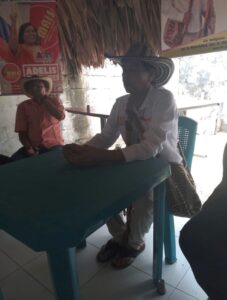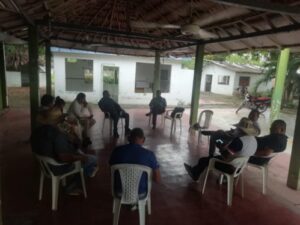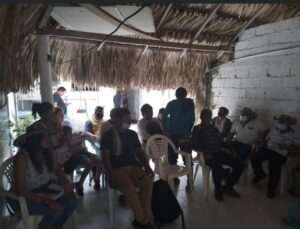TRAINING REPORT
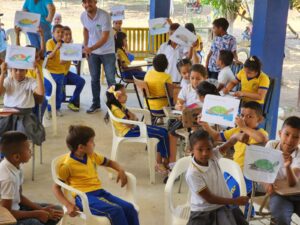
SACANA-Córdoba, COLOMBIA.
• Starting Date: July 04, 2022
• End Date: December 31, 2022
This project will evaluate the development of capacities through the methodology proposed by the IUCN (see at: https://portals.iucn.org/library/sites/library/files/documents/Rep-2015-005-Es.pdf):
▪ GOAL: The project indicators fully evaluate the development of conservation capacities through the impact and behavior change of the Zenú indigenous community participating in the project.
▪ Target sample: 500 people; 95% statistical confidence.
METHODOLOGY AND CRITERIA
Next, we will establish the main evaluative milestones in the development of restoration/reforestation capacities in the Zenú indigenous community; We will assign values from 1 to 5 based on compliance with the following criteria and describe recommendations and observations for future experiences:
▪ The Zenú indigenous community has 500 leaders who have (1) clearly assigned responsibility, authority, and take responsibility for forest restoration, (2) Expertise in the execution of the fight against forest erosion, and (3) Sufficient time to sensitize the Zenú indigenous community
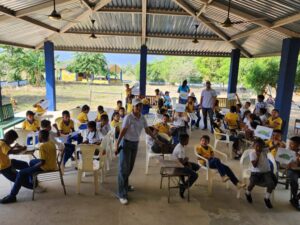
-Source of verification: Project report; surveys and focus groups.
▪ The project receives sufficient support from 6 expert people from the COLOMBIA WILD CORP work team (proponent of the project) and from a network of volunteers of 50 people, in all project activities.
-Source of verification: Project report
▪ The Zenú indigenous tribal chiefdom (leaders of project beneficiaries) has established a clear responsibility for post-project seedling monitoring, and has developed adequate capacity to continue replanting an additional 20,000 trees, using the nurseries. Technical assistance from the University of Amazonas.
-Verification source: strategic planning of the Zenú indigenous tribal chiefdom.
▪ The project has developed probable sources of long-term financing for monitoring, reintroduction of new seedlings, and support for micro-enterprises related to reforestation, for the next five years.
-Source of verification: Copy of territorial marketing plan
▪ The land management plans of the Zenú indigenous community include prohibitions and restrictions on ecological corridors and the 4,000ha of protected natural area in the territory (Escazú agreement).
-Verification source: copy of land use plan; strategic planning of the Zenú indigenous tribal chiefdom.
▪ The project team and its program are favorably received and supported by the Zenú indigenous community.
-Source of verification: Project report; surveys and focus groups.
COMMUNICATION OF RESULTS
Identify the audience that will receive the message and we will communicate the results of the evaluation through meetings, conferences, audiovisual (TV, radio), written (websites, magazines, newspapers) or social media (Facebook, Twitter). The information will be clear and concise; We will use graphics.
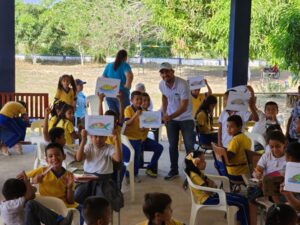
1. BUILDING CONSERVATION CAPACITIES IN THE ZENÚ INDIGENOUS COMMUNITY
One of the most important pillars of our project is the development of conservation capacities of the Zenú indigenous community, through educational sub-program, designed with a gender perspective and with an inclusive character. The structure of the educational plan has 3 axes:
1.ENVIRONMENTAL LEADERSHIP TRAINING (500 young beneficiaries)
Activity-2.1. Develop 50 days of environmental education for 500 Zenú indigenous youth, in the fight against illegal traffic of Colombian forests.
▪Methodology: Using the socio-constructivist learning method as a pedagogical strategy, 50 trainings will be held, lasting 4 hours, per training. A snack will be offered to the participants. The trainings will begin with an initial diagnosis, consulting previous knowledge, and study plan. Topics:
(i) Conservation and agroforestry techniques.
(ii)Administration of protected natural areas and use with sustainable development.
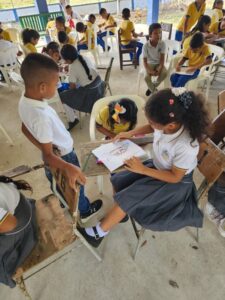
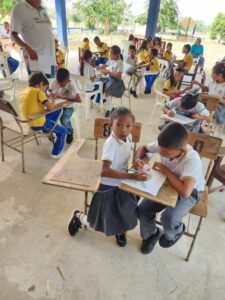
Pedagogical strengthening field practices:
▪Community training activities carried out by the participants of the project trainings.
▪Tree planting and monitoring activities.
▪Activities for the construction of greenhouses (ethnobotany).
2. FAMILIAR ENVIRONMENTAL AWARENESS (At least 5,000 people)
Each of the 500 young people trained will choose one or two families of training partners, to carry out an awareness ‘in situ’. Use of banner and reminder.
▪For indigenous people over 18 years of age
Activity-2.2. Awareness in sustainable management of Colombian forests, to each of the 500 families of the 500 young people trained, carried out by themselves in exchanged homes (3,000 beneficiaries).
▪For children and adolescents (8 to 18 years old)
Activity-2.3. Conference in 5 Zenú educational institutions, to sensitize 1,500 indigenous people about the conservation and reforestation of the turtle habitat.
3.CREATION OF ALTERNATIVE LIVELIHOODS BASED ON REFORESTATION (At least 30 enterprises training)
Activity-A2.4. 10 mentoring to strengthen the 30 enterprises based on reforestation, led by 30 Zenú indigenous women.
▪Course for 30 indigenous women micro-entrepreneurs
-Ecotourism and forest tourism services.
-Digital media marketing strategies
-Customer service course and basic English
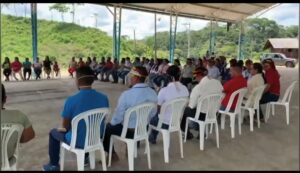
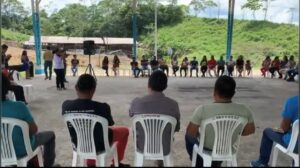
TRAINING AGENDA
These trainings are a joint initiative of FUVERDE FOUNDATION and USFWS.
BACKGROUND: It is estimated that the Colombian tropical forests in the Zenú indigenous territory, around the city of Sacana, in the province of Córdoba, have lost approximately three quarters of Carranchina turtle and this populations now represent less than fifty percent of the country’s populations. Critical environmental goods and services have been lost, disasters such as wildfires, landslides and flash floods have become more common, and the livelihoods of many rural and indigenous communities have been compromised.
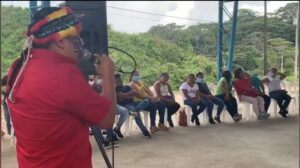
Therefore, the present massive conservation program has been implemented in 144Km2 of this area, to counteract these problems. 5 fast-growing native tree species of fast-growing exotic tree species have been used, which are particularly suitable for meeting program objectives. They also tend to be carried out on a community-based with follow-up, as well as engaging local communities in a more meaningful way. An agroforestry system known as “Rainforest Agriculture” was developed, which uses native species to rehabilitate degraded landscapes, while providing forest-dependent communities with a more sustainable source of livelihood. Equally important, they worked on an approach to facilitate the coordination of the response to outbreaks of forest fires caused by climate change. Through this project, interest in forest restoration, organizing indigenous Zenú communities, addressing land tenure issues, and ensuring equitable distribution of benefits was stimulated. Subject to extensive research and experimentation, “rain forest agriculture” has been refined into a profitable and widely applicable strategy for reforestation. Other methods, known simply as “rainforestry”, are also planned in the future to rehabilitate critical watersheds, denuded portions of protected areas, and landslide areas, where income generation plays a less important role.
The Colombian state through the REGIONAL ENVIRONMENTAL SECRETARIAT FOR THE MAGDALENA – CORPOMAGDALENA has endorsed the project as an official reforestation strategy, but dissemination of this approach to the provinces has been limited and technical capacity remains inadequate. To overcome these obstacles, FUVERDE FOUNDATION conducted 30 training sessions for 500 Zenú indigenous youth, with the aim of expanding the adoption of this restoration strategy in the next 5 years.
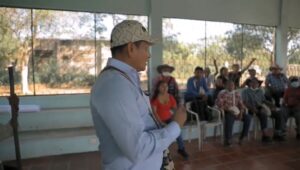
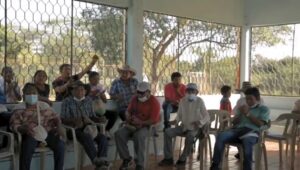
OBJECTIVES: The most specific objectives of this training course were the following:
1. Provide participants with a solid understanding of reforestation with an emphasis on reptile conservations, and its application in various social and ecological contexts;
2. Teach participants through hands-on and experiential learning, the process and practice of establishing a reforestation site and a native species nursery.
3. To catalyze additional training on conservation, train the use of forest, with the assistance of the regional institutions office.
4. Develop more sites of forest islands with a firebreak format, for the coordination of forest fire control.
5. Promote the exchange of experiences, lessons learned and best practices for the application of Rain forestry to 500 Zenú indigenous families.
PROGRAM LOG
Instructors
• ANGELITA ORIAS
• MARLÓN BANDE
July 4 – July 20/2022: The course began with the opening words of the director of the project LINA MARCELA NAVARRO BUELVAS, and the coordinator of the program JUAN DAVID MARTÍNEZ SOTELO. The 500 participating instructors were then introduced, led by the instructors: Angelita Orias and Marlón Bande. The training itself was started with an introductory lecture that described the history of biodiversity loss in the Zenú indigenous territory, the limitations of conventional reforestation approaches, the social and technical processes to establish fire control sites (firebreaks) and the ecological and social benefits of forest restoration. Instructor Angelita Orias gave an introduction to the different tropical forest formations, emphasizing the importance of understanding the forest ecosystem where it is being planned.
Instructor Marlón Bande followed with a presentation on alternative strategies to forest restoration, such as Assisted Natural Regeneration and the Framework Species Method, and compared the two, based on ecological and social contexts and management objectives. To give participants a better idea of the approach, the group visited three Rainforest demonstration sites in the area, where they also had the opportunity to discuss the implementation process with the communities and individuals who developed the sites.
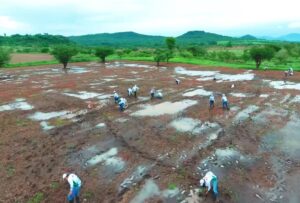
July 21 – August 6/2022: El Marlón Bande gave an introductory presentation on the establishment and operation of native tree nurseries. The participants then toured the facilities of the 5 nurseries built by the project, where they learned about several ongoing experiments that support the refinement of conservations methodology, including those that analyze the development of forest tree roots in different types of soil; the relative growth of trees under different nutrient levels and seedlings; shading requirements.
Participants proceeded to the original demonstration site, where they studied the impact of fires on native trees and forest growth, and examined soil characteristics in the region. Participants also completed exercises on monitoring seedling growth in the nursery, where they learned how to measure seedling height and root collar diameter, and monitoring planted trees by geo-tagging them and measuring height and diameter. the diameter of the trees. Marlón Bande then facilitated a session on data analysis using the information collected during the exercises.
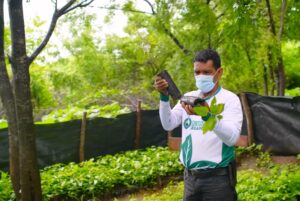
August 7 – August 22/2022: The participants traveled to San Antonio de Palmitos and Chicorodó, where some of the primary forests victims of the forest fires are located, which remain in the Zenú indigenous territory. Before reaching the forest, participants walked along a portion of a newly established interpretive trail, where they were introduced to forest dynamics such as degradation, succession, and natural regeneration along spatial and temporal gradients. Participants also stopped at food plantations and a quarry along the trail to briefly discuss the socio-political factors behind interests in Amazonian forests. The group then met with a forest community and learned about their efforts to protect and rehabilitate the Amazon Basin and sustainably manage their forest area. Engineer Angelita Orias demonstrated how to properly collect the wild plants, transfer them to plastic bags, inoculate the seedlings with mycorrhizae, set up a recovery chamber, and plant the seedlings. The participants then did all the activities themselves in the community’s watershed area as a way to contribute to the community’s rehabilitation initiative.
August 23 – September 10/2022: Angelita Orias began the day with a discussion on the importance of monitoring transplanted seedlings; the coincidence between species and sites and the morphological characteristics of the native species. Subsequently, the participants visited a firebreak site already built by the project, in an area with a high threat of forest fire; in a marginal area, exploring the different combinations of species and shade and nutrient treatments. In the adjoining area, participants grouped together and conducted an initial site assessment, conducting a vegetation survey and a mock interview with landowners.
Using the results of the survey and interview, the groups deliberated on an appropriate strategy to reforest the area and presented their plans for feedback. Following this exercise, participants were given time to develop their own action plans, setting out in detail how they plan to apply what they have learned from the training once they return to their own communities.
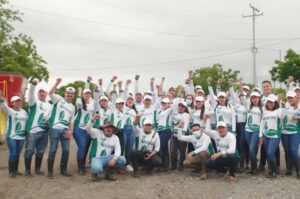
September 12 – December 31/2022: The last months of training was dedicated to community awareness with presentations of action plans and comments addressed to 5 educational institutions in the region and 500 families (one for each training participant). We estimate at least 8,000 indigenous people reached with this massive awareness strategy. Angelita Orias then gave a presentation on the Leadership Program and discussed the different opportunities for follow-up support to implement her action plans. The training ended with an evaluation of the course, closing remarks from the project coordinator, and the issuance of certificates.
Participants: The training was attended by 500 participants, including representatives of Local Government Units, farmers, educational institutions, fishermen, and housewives. The participants were all indigenous Zenú.
Follow-up: All the participants followed the progress of the activities, as volunteers, in tasks of operations, direction and monitoring of seedlings (to date); also, in the implementation of their action plans and will provide the assistance requested directly by the Zenú indigenous tribal council or through the Fundesabanas corporation. These activities are just the beginning: there will be more courses to come.
INCLUDE AN ALTERNATIVE LIVELIHOOD COMPONENT? PLEASE DESCRIBE HOW IT RELATES TO REFORESTATION/RESTORATION ACTIVITIES
Planting trees will not make a difference if local people do not get involved to protect those trees and help them grow, adopting alternative livelihoods based on forest restoration; therefore, This project has reserved 4 activities closely related to the development of livelihoods related to reforestation:
A3.1. Creation of the productive chain of enterprises based on reforestation, which integrates 30 micro-businesses made up of women.
-Methodology: opening of a regional office to bring together enterprises related to reforestation; creating the reforestation value chain in Zenú indigenous territory. Invitation to 30 enterprises, chamber of commerce and the University of Amazonas.
A3.2. Implementation of a territorial marketing plan for the promotion of the Zenú indigenous territory, through digital media channels.
-Methodology: Personalization of the Zenú indigenous culture, territorial marketing, advertising campaigns; promoting the territory, culture, gastronomy, 4,000ha of natural area and the observation of endemic birds and amphibians. We will connect 30 indigenous women entrepreneurs with a team of dedicated mentors and technical expertise to strengthen their value propositions and business models.
A3.3. Personalization of the project. Use of social networks and the project website to publish 30 enterprises; project activities and results.
-Methodology: opening of social networks and website; publication of project material: interviews, videos, live, captions, reels, stories, etc.
A3.4. Holding of 1 regional trade fair to promote enterprises based on reforestation of the Zenú indigenous community.
-Methodology: Holding of a trade fair; participation of the 30 enterprises related to reforestation; invitation of potential clients, regional enterprises with complementary services and products.
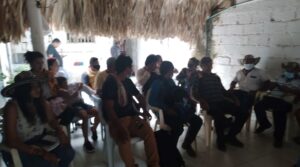
TARGET GROUPS FOR THIS TRAINING AND HOW WILL IT BE IMPLEMENTED
In our Activity 2.4: ’10 mentoring to strengthen the 30 enterprises based on reforestation, led by 30 Zenú indigenous women’ a two-month training program that will counsel 30 women leaders who develop businesses of conservation, reforestation, agroforestry and other regenerative practices. The 5-week program ends with two Impact Days (August 30 and 31, 2023) where the entrepreneurs will present their business models to a group of impact investors, financial and technical experts, and the Colombian government.
We will carry out educational tours, field days in forests in the process of restoration, workshops, producer-to-producer exchanges, training for women leaders, individual corporate support (mentorship). Additionally, the 30 entrepreneurs will be enrolled in free online courses (webinars), expert support, and a study platform with material to deepen the content. The experts in charge of the classes are sustainable leaders and entrepreneurs with extensive experience.
After the terrible economic consequences of the pandemic due to COVID-19, we propose sustainable recovery for the benefit of ejidos, communities, small owners and private companies of the Zenú indigenous territory, promoting community forest management ventures that generate jobs, including: nurseries, forestry companies; the timber harvesting and transformation industry, as well as increasing the forest area through investment in works related to forestry.
Our organization undertakes to provide scholarships for undergraduate and graduate degrees in disciplines related to conservation, in national and international universities (example: Professional Development Grants of WWF-EFN).
▪Project stakeholders:
1.Zenú indigenous community (beneficiaries)
2.CorpoMagdalena (partner)
3.FUVERDE FOUNDATION (proponent)
4. USFWS (Sponsor)
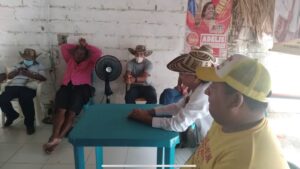
IDENTIFY ALTERNATIVE LIVELIHOODS BEING SUPPORTED IN THE IMPLEMENTATION OF
THIS PROJECT
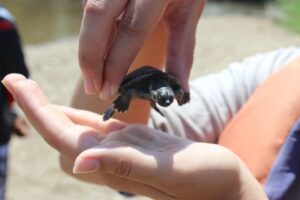
Our initiative financed by USFWS will serve as a flagship project to promote the impact of the 30 ventures based on reforestation, led by 30 indigenous women. These micro-enterprises already exist, but they have no commercial relevance because they have not been supported or advised.
▪Local or community ecological tourism: forest islands for the (non-invasive) observation of endemic birds, reptiles and amphibians; pink dolphin sightings are highly prized by outdoor enthusiasts. Visit the protected, reforested and canalized natural area, free of erosion and with a monitoring system for reintroduced plants.
▪Carbon trading (in relation to climate change): sale of Certified Emission Reductions (CERs) from afforestation and reforestation activities (carbon sequestration): ensures work in close collaboration with farmers and rural communities; and promotes the use of native species in reforestation, to ensure payment for carbon sequestration and emissions reduction.
▪Other payments for environmental services such as water (conservation of important water basins under forest cover, biodiversity, etc.).
▪Sale of indigenous handicrafts
By supporting the 30 entrepreneurs, we estimate the improvement of the family income of 200 local farmers, through the sale of non-timber forest products: handicrafts, furniture, excess wood, and maintenance of forest islands for observation of endemic biodiversity (ecotourism).
